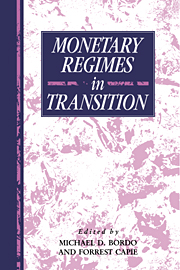Book contents
- Frontmatter
- Contents
- List of figures
- List of tables
- List of contributors
- 1 Introduction
- Part I Commodity money standards in transition
- 2 The scramble for gold: monetary regime transformation in the 1870s
- 3 The Latin Monetary Union and the emergence of the international gold standard
- 4 Greenback resumption and silver risk: the economics and politics of monetary regime change in the United States, 1862–1900
- Part II Successful and unsuccessful adherence to the gold standard
- Part III Wartime upheaval and postwar stabilization
- Part IV Perspectives on monetary regimes
- Index
3 - The Latin Monetary Union and the emergence of the international gold standard
Published online by Cambridge University Press: 05 May 2010
- Frontmatter
- Contents
- List of figures
- List of tables
- List of contributors
- 1 Introduction
- Part I Commodity money standards in transition
- 2 The scramble for gold: monetary regime transformation in the 1870s
- 3 The Latin Monetary Union and the emergence of the international gold standard
- 4 Greenback resumption and silver risk: the economics and politics of monetary regime change in the United States, 1862–1900
- Part II Successful and unsuccessful adherence to the gold standard
- Part III Wartime upheaval and postwar stabilization
- Part IV Perspectives on monetary regimes
- Index
Summary
In 1865 France, Switzerland, Italy, and Belgium agreed to coordinate their monetary systems under the rubric of the Latin Monetary Union. Although pervasively mentioned in monetary histories of Europe, the rationale for the establishment of the Latin Monetary Union is not well known, and its role in the development of European monetary systems has not been correctly understood. It is most frequently viewed as an attempt to establish a bimetallic standard in Europe, and is therefore seen as a failure or dead end in the evolution of the European monetary system.
In this chapter I show that rather than being a bastion of bimetallism the Union was formed because the member countries were on a de facto gold standard. It is no coincidence that the Union was established after the rapid decrease in the price of gold in the 1850s drove silver out of the circulation of each of the four countries. This caused a dramatic shortage of smalldenomination coins and prompted the introduction of token coins. However, although each of the four nations had the same full-bodied coins, they introduced different token coinages. Efficient management of the token coinage required cooperation amongst the four countries. The Union established a common token currency: it stated the type of token, the quantity that would be issued, and the conditions for convertibility.
The Union should be viewed as a step on the path to gold monometallism – not as a dead end attachment to bimetallism.
- Type
- Chapter
- Information
- Monetary Regimes in Transition , pp. 68 - 85Publisher: Cambridge University PressPrint publication year: 1993
- 3
- Cited by



